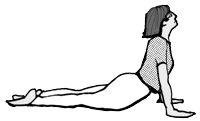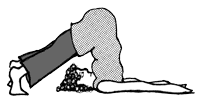At eighteen, I started yoga with a book as my teacher and I haven’t stopped practising since. I recently turned fifty-six. What have I learned after all these years? I sense cycles like in the Sun Salutation, of something starting and coming round full circle to end in what seems to be the same place. Looking at yoga and me today, has anything changed?
For one thing, yoga has hit the mainstream. Diverse approaches offer a different flavour for every taste, responding to the variety of practitioners’ and their motivations. Do we all speak different languages with our bodies or just different dialects? Does variety result in separation or awareness of commonality? What if we slow down and discover what is hidden — within ourselves and within yoga?
In the Hidden Language approach to Hatha Yoga, founded by Swami Sivananda Radha, the asanas can be realized as mudras, sacred seals or gestures. If we want to understand what secrets they hold, we can inquire and reflect and begin to loosen up what has been sealed away — in our bodies, in our minds, in the potency of the poses themselves.
This intuitive approach to Hatha Yoga starts with the very personal — your observations, your mind, your body, your relationship to the world. And it expands out to the universal, to the mythologies of our cultures, and to the interconnection among us through the subtle force sustaining all life.
We can open to our inner life through the asanas if we are receptive to their hidden meaning and to our own hidden depths. With Hidden Language Hatha Yoga, we each compose our own book of knowledge and expand our awareness of the sacred in ourselves and in our world.
When I first started yoga, I was excited and imaginative, anticipating ecstatic spiritual experiences along the line of drug hallucinations. I thought yoga would lift me up so high that I would become something other. The reality is that I am more myself than ever, and yet I question ever more deeply who that self is.
From the ground of the asanas, I continue to stretch into new territory — with my body offering rich information and my mind expanding to question who it is that is experiencing. The more I practise, the more there is to learn. This sense of newness encourages me. I like an open system. Even though I repeat the same asanas again and again, they are never exactly the same; and so it is with me. I am the same but different.
Swami Radha understood symbolism as a key to opening to the world around us, to interpreting different spiritual traditions, and to finding the Divine within. As human beings, we are walking symbols holding a central mystery.
Many spiritual practices draw us toward this mystery. By integrating self-inquiry with the intelligence of the asanas, Hidden Language is particularly effective in activating a questioning attitude and stimulating a desire to find out more.
For me, yoga is an ever growing understanding of myself as a whole. It is also the process — a process that synthesizes levels of consciousness, from the most basic to the most elevated. Through yoga, I recognize the unity and preciousness of my human life and the beauty of all life around me. I see how wonderfully interconnected we all are, and how powerful the delicate interconnection of body, mind and speech.
poses & reflections
Hidden Language helps us unite the body, mind and speech and can give us access to this wisdom within ourselves. Through working with the body, opening to the symbolism, listening, and accepting what rises to the surface, we encourage a process of clarity and a movement toward what is real for us. The practice opens us to intuitive perception. As we learn to trust our intuition, we can become our own teachers — uniting the student and teacher within.
garudasana (the eagle): awareness
“Awareness” best describes both the process and the goal of yoga. We want to wake up and see more, understand more, open to greater knowledge. Awareness starts by bringing attention to what is and understanding it for ourselves.
Is there a situation in your life that feels unclear or murky? Go into the Eagle pose, bringing in the eagle’s clear sight and detached observation. What do you see? How do you contribute to this situation? Can you make a change?
bhujangasana (the cobra): choice
When we recognize our patterns in practice, we start to become alert to how these underlying dynamics play out in other areas. In the knowing comes the power of choice. Do I want to stay this way? Do I want to continue to entertain this thought or can I let the thought go, and in doing so, the associated tension in my body?
knowing comes the power of choice. Do I want to stay this way? Do I want to continue to entertain this thought or can I let the thought go, and in doing so, the associated tension in my body?
Consider the paradoxical nature of the serpent — how in its silent approach it can represent either wisdom or temptation. Do the Cobra pose looking at a current situation, first with the eyes of wisdom; then observing the temptations. What is the response in your body, mind and emotions?
halasana (the plough): action
Karma Yoga is the yoga of action. We cannot live without acting. By necessity, we also must sacrifice other life to support our life. How then do we act?
As you do the Plough pose, ask yourself: What actions do I need to take? What work is before me at this time? What attitude can I bring to this work to make it yoga?
vrksasana (the tree): devotion
Devotion can be present in any of the poses,
depending on our attitude and awareness. Devotion is simple and demands few words. We just need to let go and make everything we do an offering, with respect, back to the source of life.
As you stand in the Tree pose, be aware of the gesture Namaste — the Divine in me greets the Divine in you. Can you feel the Divine in yourself? Can you genuinely extend that feeling out to others?
paschimottasana (sitting forward bend): union
How do we unite Earth and Heaven, body and mind? We can observe the duality of the upper and lower, the left and right sides in our own bodies, and see how the asanas bring these dualities into unity.
As you practise the Sitting Forward Bend, the movement is toward union of the upper and lower. Ask: How can my two selves come together? What are these two selves?
Excerpted from Swami Lalitananda’s latest book, The Inner Life of Asanas.